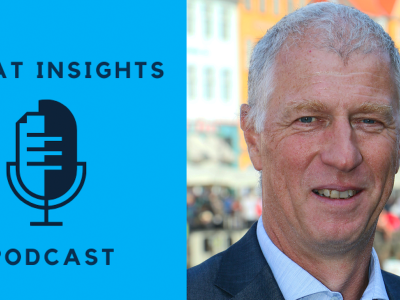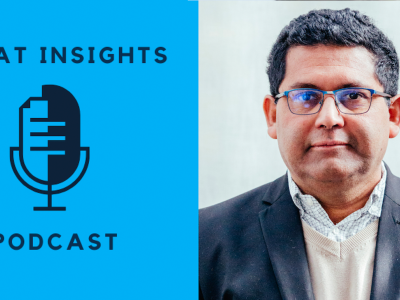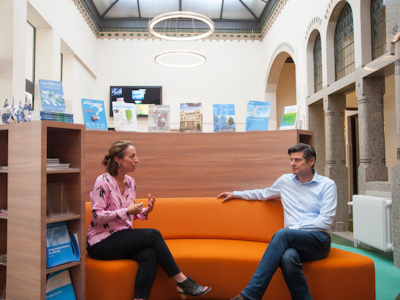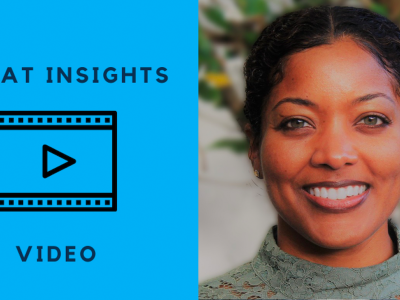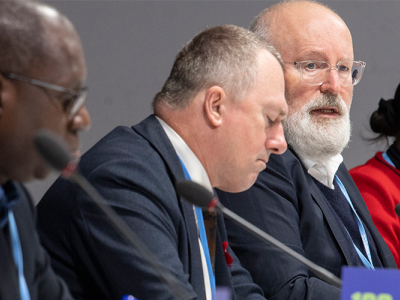
The key to effective climate adaptation in Africa
The Global Center on Adaptation (GCA) is driving Africa’s adaptation in agriculture, infrastructure, youth entrepreneurship and job creation, and climate finance. With endorsement of the African continent, GCA’s solutions provide value for money for the $100 billion climate finance that must be delivered by COP26.
Interview with Prof Anthony Nyong, Regional Director Africa at the Global Center on Adaptation
You have been Regional Director for GCA Africa since early this year. What are GCA Africa’s objectives and next steps when it comes to climate adaptation?
The GCA is the only global organisation that has the support of Heads of State from the OECD, Africa and other regions and focuses solely on the climate adaptation and resilience agenda.
We deliver action on the ground, at scale, through the mobilisation of finance and the implementation of innovative programmes for adaptation. Our work focuses on supporting the most vulnerable to adapt to climate impacts. GCA therefore prioritises Africa, where the demand for adaptation and resilience is high. We work with amongst others the African Development Bank (AfDB) on the jointly developed Africa Adaptation Acceleration Program (AAAP). That programme aims to mobilise US $25 billion to drive adaptation, focusing on four key areas: climate-smart digital tools for agriculture and food security; resilient infrastructure; youth empowerment and job creation; and climate finance.
The AAAP links demand with promising and successful initiatives, scaling up what works to drive Africa’s economic development in ways that are inclusive, climate-resilient and sustainable. We support the design of projects to strengthen adaptation and resilience building, for instance by multilateral development banks. We aim to work with and for all African countries, partnering with the African Union Commission, the public and private sector, knowledge institutes, civil society and key development partners.
A recent GCA study on adaptation finance in the context of COVID-19 reported a reversal of the decade-long trend of increasing adaptation finance for developing countries. What do you see as the best way forward to close the adaptation finance gap amid the global crisis?
Even prior to COVID-19, global attention had always skewed towards mitigation, taking up over 90% of the resources, with less than 10% going to adaptation. It is important to focus more global attention on adaptation and demonstrate political will to finance adaptation. The COVID-19 crisis has further constrained climate adaptation. Rising government debt has complicated domestic resource mobilisation, and global climate finance decreased by 10% in 2020. As a result, climate impacts far outpace adaptation action. To break with this trend, adaptation must be mainstreamed in COVID-19 recovery plans, and in development agendas, leveraging the triple dividend of responding to the health crisis, driving Africa’s economic development and building climate-resilient societies.
It is generally estimated that about 75% of the resources needed to combat climate change will come from the private sector. Innovative financial instruments are needed to support micro-, small- and medium-sized enterprises and larger players. Resilience bonds or de-risking instruments, and enhanced ease of doing business, are crucial to mobilise the private sector. Let us not forget that developed countries also have a key responsibility: they still have not met the $100 billion financial support committed to in the Paris Agreement, of which 50% is to be allocated to adaptation. This commitment can and must be met.
Also, the plan of the International Monetary Fund to issue $650 billion in new Special Drawing Rights (SDRs) to boost global reserves and liquidity will be enormously helpful to increase the fiscal space to plan and spend on adaptation. It would be even more helpful if developed countries agreed to allocate a significant share of their own SDRs, especially to the more vulnerable developing countries. By expanding fiscal space, the SDRs can make a big push on climate finance, and a bigger push for climate adaptation.
Your current position at GCA is a secondment from your position at the AfDB where you served as the Director of Climate Change and Green Growth. The AfDB is the climate adaptation champion among the MDBs. Two-thirds of its climate finance goes to adaptation, compared to about 10% for the European Investment Bank. What lessons can be learned from the AfDB on creating attractive investment for adaptation?
For Africa, a low-emitting continent, the main priority is adaptation. The African Development Bank is supporting many mitigation initiatives, but aligning to expressed needs, it has focused on adaptation. This remains a challenge: designing and implementing adaptation projects is less straightforward than most mitigation projects. Securing funds for adaptation is also complicated. The AfDB, as well as the GCA, works to defy these complications. Importantly, it focuses on changing the narrative on adaptation from being a public good to being simply smart economics: the benefit-cost ratio for adaptation and resilience projects is quite good, ranging from 4:1 to above 10:1. Designing adaptation interventions to bring out these benefits and giving resilience value is essential to attract private sector investors. The AfDB is doing this, encouraging impact investors in the adaptation and resilience space.
The African Development Bank is also supporting public sector investments while countries are facing the COVID-19 crisis. At the onset of the COVID-19 pandemic, the AfDB set up a $10 billion COVID-19 response facility to support African countries to flatten the COVID-19 incidence curve. The AfDB also launched a $3.5 billion COVID-19 social bond. By carefully mainstreaming adaptation into these responses, they are supporting African countries to chart a stronger and climate-resilient recovery pathway, thereby mobilising available and additional finance for adaptation.
In African countries, adaptation in agriculture and food systems is crucial, since the majority of people is dependent on rainfed agriculture. But science shows that crop yields will decrease tremendously due to climate impacts. What is your advice on the key steps that African countries, which are so dependent on agriculture, should take to better adapt their agri-food systems to climate impacts?
Agriculture is a crucial sector in Africa’s economies and in climate adaptation. Today, over 50% of Africa’s population is food insecure. Some 280 million Africans are malnourished. If no action is taken, climate impacts will lead to overall yield reductions of up to 30% by 2050, while extreme weather events will result in higher post-harvest quality and quantity losses. Evidently, adapting agri-food systems is needed. This requires a holistic approach, looking not only at production but also at markets, policies and transportation. At the farm level, it requires supporting Africa’s 250 million smallholders, of which 40% are women, as they are most at risk of climate change impacts.
Luckily, adaptation solutions exist. Drought or heat resistant crops have already raised the productivity and income security of millions of African farmers. So have digital solutions such as weather, climate and market information, advice, and access to insurances. As of now, over 400 digital agriculture solutions are said to have helped an estimated 32 million African farmers increase their yields by between 40-70%. Having the potential to reach many, also those in remote areas, in efficient and targeted ways, it is crucial to scale these solutions up. To do so effectively, basic weather observation stations must be established and the capacity to transform this into usable information must be improved. Today, 70% of Africa’s infrastructure is yet to be built. To reduce post-harvest losses, enhance urban food security and increase farmers’ income, the development of more and resilient infrastructure is also essential.
GCA is headquartered in the Netherlands, and its mandate is to push strongly for more effective adaptation in developing countries. However, “adaptation” – and especially adaptation finance – has been a contentious topic between Europe and Africa. Now, given the efforts of GCA and others, do you see potential for better cooperation between Europe and Africa on adaptation, for example, in the run-up to COP26?
Europe is being devastated by floods and the region understands the need for adaptation and resilience. I do not see any conflicting interests between Europe and Africa on adaptation. As a matter of fact, Europe is Africa’s strongest supporter of the fight against climate change. However, a lot more is needed. European countries are increasingly understanding that Africa cannot and should not bear the burden from the climate impacts it faces alone. Africa’s adaptation is an increasing priority in European development strategies. However, plans do not yet align with actions and figures: Africa only received 3% of global climate finance. This cannot be acceptable. If we want to achieve the SDGs, and not reverse the progress we already made towards achieving them, this figure must change drastically. As the knowledge and solutions are available, there are no longer excuses not to act.
COP26 provides a key moment and platform to change course, to ensure that large parts of the committed $100 billion will be channelled to Africa for adaptation. As GCA has the adaptation solutions Africa needs, I am hoping to see a significant increase in support to GCA to tackle adaptation, especially through the AAAP.
You were also a coordinating lead author for the Intergovernmental Panel on Climate Change (IPCC) 4th Assessment Report. Knowing very well the possible negative impacts of climate change on the African continent, what are you hoping to see as a result from the upcoming COP26?
Africa and its adaptation challenges are still not sufficiently taken seriously. It is estimated that climate change will cost Africa about $50 billion per year by 2040 if concerted actions are not taken now. This has global implications. At COP26, more support must be provided, and more room must be given to African countries and stakeholders to lead the adaptation agenda and discussions. The yearly $100 billion committed by developed countries to support developing countries should have commenced last year and did not have to wait for COP26 – it was not tied to COP at the time of pledging. These resources must become available and be spent in the most effective, sustainable and equitable ways.
For that, specific actions and solutions are needed that meet the scale of the demand and ambitions. The AAAP is a vehicle that can be used as a fit-for-purpose mechanism to accelerate adaptation. GCA stands ready to support African countries and global partners to safeguard African societies and realise the Nationally Determined Contributions and National Adaptation Plans. We have the solutions that work and we are bringing together the key actors needed to implement them at the required scale. GCA will come to COP26 showing clear progress on the implementation of the AAAP, and we aim to leave COP26 with additional partnerships and collaborations to drive the implementation of the AAAP and further realise its goal to mobilise $25 billion by 2025 for the continent.
About Professor Anthony Nyong
Before his appointment at GCA, Professor Nyong served as Director of Climate Change and Green Growth at the African Development Bank and has over 30 years of experience in environmental and natural resources management, renewable energy and green growth. Mr. Nyong holds a Ph.D. in Geography from McMaster University, Canada. He is a Senior Executive Fellow of the Harvard Kennedy School of Government, a Chartered Geographer and a Fellow of the African Academy of Sciences. He was also named among the top 20 of the 100 most Influential People in Climate Policy 2019 by Apolitical.
Read the full magazine issue
This article appears in the climate edition of ECDPM's Great Insights magazine – check out the full issue or the other articles and multimedia below.







